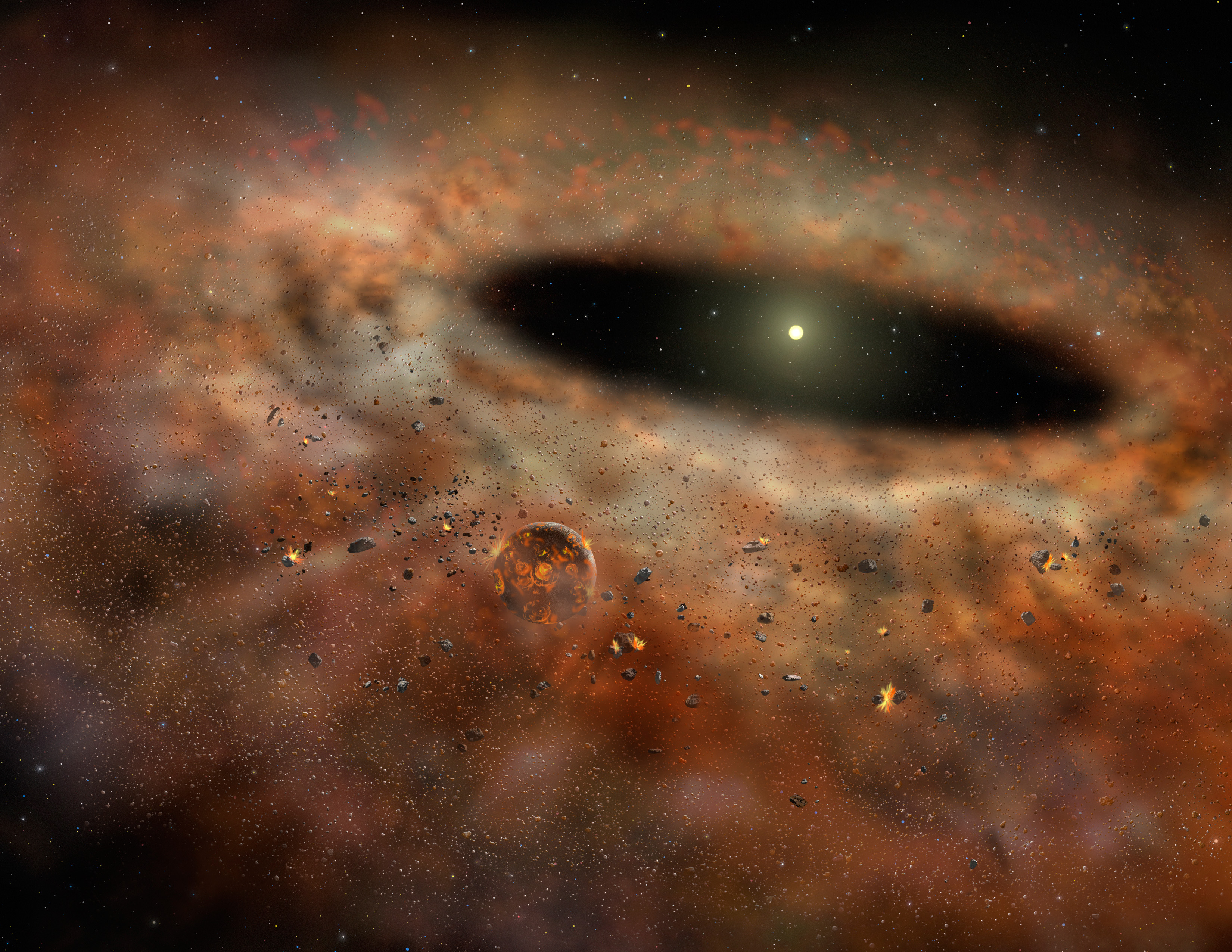







| BOOKS | F. A. Q. | ARTICLES | TALKS | ABOUT KEN | DONATE | BEYOND OUR KEN |
|---|
By Ken Croswell
Published on ScienceNOW (July 4, 2012)

Now you see it...: In less than two years, a young star lost the dusty disk shown in this artist's conception. Credit: Gemini Observatory/AURA artwork by Lynette Cook.
Some 460 light-years away in the constellation Centaurus, a thick disk of dust swirled around a young star named TYC 8241 2652 1, where rocky planets like our own were arising. Then, in less than two years, the disk just vanished. That's the unprecedented observation astronomers report in a new study, out today. Even more intriguing: the same thing may have happened in our solar system.
Born about 10 million years ago, the TYC 8241 2652 1 system was chugging along just fine before 2009. Its so-called circumstellar disk glowed at the infrared wavelength of 10 microns, indicating it was warm and lay close to the star--in a region like the one that, around the Sun, gave rise to the terrestrial planets Mercury, Venus, Earth, and Mars. The infrared data reveal that the dust was about 350 degrees Fahrenheit and located as close to its star as Mercury is to the Sun.
By January 2010, however, nearly all infrared light from the star's dusty disk had vanished. "We had never seen anything like this before," says astronomer Carl Melis of the University of California, San Diego. "We were all scratching our heads and wondering what the hell did we do wrong?" But subsequent observations with both infrared satellites and ground-based telescopes confirmed the surprising discovery, he says: "The disk was gone."
Melis and his colleagues report the mystery online today in Nature--but they don't know what caused it. "It's very bizarre," he says. "Nothing like this was ever predicted." He says there's no way something could eclipse the infrared-emitting disk for more than two years, because such an object would be immense. Furthermore, the star itself didn't fade.
Melis speculates that an earlier collision between two objects--perhaps two boulders, two asteroids, or even two planets--orbiting the star produced the dust grains that emitted the infrared light. Then either the star's light blew the dust out of the planetary system or the dust plunged into the star.
"It's a really interesting mystery," says astronomer Scott Kenyon of the Harvard-Smithsonian Center for Astrophysics in Cambridge, Massachusetts, who was not affiliated with the discovery team. "The observations certainly seem correct. It's sort of amazing to have the dust in one of these disks go away so quickly. It's hard to know exactly what happened."
"This is a whole new insight into the violent processes like the ones that formed the Moon and that must be going on where terrestrial planets are forming and first evolving in other planetary systems," adds astronomer George Rieke of the University of Arizona in Tucson. Rieke says the discovery shows what happens after members of a nascent planetary system collide. His team has recently found milder infrared dimming in two somewhat older stars, indicating that similar events may be occurring there.
The discovery may offer clues to the violence that surrounded the formation of Earth. In particular, Earth is the only known terrestrial planet with a large moon, whose tides may have helped life advance by pushing it from sea to land; but no one knows how many Earthlike planets sport large satellites. The Moon arose when a Mars-sized object hit our planet, a collision that presumably spewed lots of dust into space. The new observations suggest this dust could have disappeared fast.
However, with only one dust-vanishing event ever seen, Melis doesn't know how common the phenomenon is. So his team plans to monitor not only this star but also others like it. "We have to wait and see if we ever catch another one," he says.
Ken Croswell earned his Ph.D. in astronomy from Harvard University and is the author of The Lives of Stars.
"A stellar picture of what we know or guess about those distant lights."--Kirkus. See all reviews of The Lives of Stars here.
| BOOKS | F. A. Q. | ARTICLES | TALKS | ABOUT KEN | DONATE | BEYOND OUR KEN |
|---|